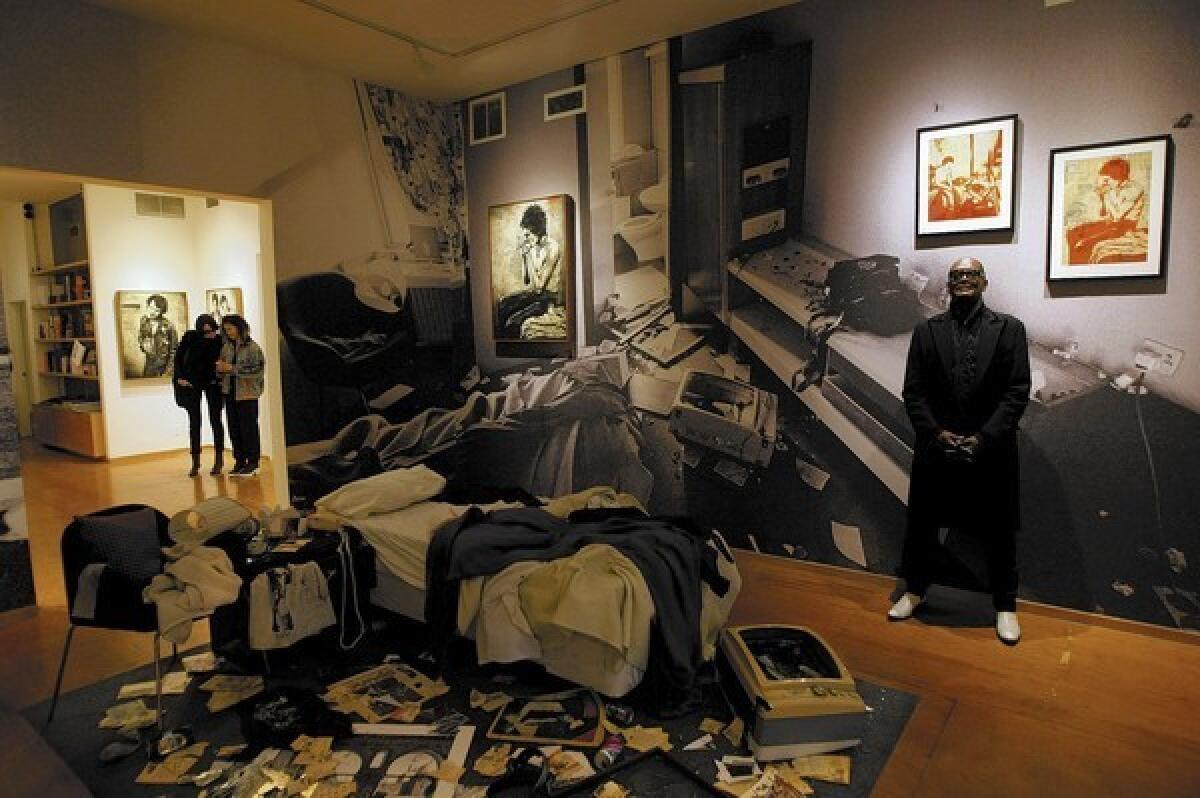Sid Vicious and the aesthetics of punk rock

The hotel room was destroyed. A television lay shattered on the ground, surrounded by a shredded pile of photographs and Bible pages, soda cans and broken furniture. On the mangled hotel bed, the sheets were coiled up in a corner, still holding the form of the human responsible for this mess. Just down the hall, Billy Idol and guys from the Sex Pistols, Blondie and Adam & the Ants banged out loud and sloppy Stooges covers late into the night.
It’s a scene Sid Vicious might have loved if he’d lived to attend the Los Angeles art opening. After all, he was there when the real thing happened.
The Sex Pistols bassist remains one of rock ‘n’ roll’s seminal icons and dark cautionary tales. He was born John Ritchie in London and was dead at 21 of a drug overdose, and his brief two years in the band made him the living embodiment of the genre’s live-fast, die-young aesthetic.
PHOTOS: Iconic rock guitars and their owners
“Sid could barely play, but he became one of the most recognized figures of a movement,” said L.A. street-art impresario Shepard Fairey, who along with longtime Pistols photographer Dennis Morris put together “SID: Superman Is Dead,” a new photography, print and installation exhibition inspired by Vicious’ life. “He was almost beautifully self-destructive, and for every 16-year-old kid who wants to do something different, there’s a visceral side to that, and we wanted to re-create it.”
The two created and supplied dozens of original images (and one mock-up smashed hotel suite) to document the idea of Sid Vicious as the patron saint of young rebellion — and as a real human with self-awareness of his celebrity and an unexpected tender side.
The show, which opened last week at Fairey’s Subliminal Projects gallery in Echo Park (with a one-off performance by Ritchie Love, a supergroup of those aforementioned punk vets), is the latest highbrow exploration of punk’s artistic aesthetics. It comes just months after “Punk: Chaos to Couture,” a fashion-centric exhibition at the Metropolitan Museum of Art in New York City.
One might wonder what new angles there are on one of pop music’s most thoroughly documented — and cliché-riddled — subcultures. But to wander the gallery is to be reminded of how radical and transformative the Pistols, and particularly Sid Vicious, were in their brief flicker of life.
Formed in the mind of producer and fashion plate Malcolm McLaren in the unremitting bleakness of late-1970s England, the Pistols were a glob of spit and nihilism in the eye of a country with, as the band famously put it, “no future for you.”
GRAPHIC: Best of 2013 | Entertainment and culture
Singer Johnny Rotten gave them a wild-eyed cackle; guitarist Steve Jones provided thrashing muscle atop drummer Paul Cook’s precise, panicked beats. But Vicious was the face of the group.
No one ever looked better onstage than he did, shirtless with a cigarette dripping from his upturned lip. His bass guitar was more of a prop than an instrument. He was a drug-addled mess and a live wire to anyone who came near him. But he burned out with such conviction that his short life became a kind of poetry.
Whatever “punk” was, Sid was all of it. It could never end well, but Morris knew he had to preserve whatever he could through his camera lens.
“One night we were playing Coventry, and this was on the tour when we’d have to go to a petrol station and call the promoter to find out if the shows were still on,” Morris said, remembering the night of the infamous hotel trashing in 1977. “We were in our hotel room playing reggae, and we heard this screaming and banging and thought, ‘Oh, Sid.’ But when it finally stopped we opened his door and said, ‘Wow!’ It was all there, proof of all that had happened.”
Morris’ black-and-white images for “Superman Is Dead” have a haunting intimacy and pull off the feat of humanizing a pop artist whose legend and image long have since eclipsed memories of him as a person. There’s Vicious grinning at a bus terminal on one of the Pistols’ final tours, when the band had to perform under assumed names after being blacklisted by promoters. There he is flexing in a ripped-to-hell tank top, well aware that he is the opposite of muscular vigor. There he is alone, lighting a cigarette in a grotty hotel room not unlike the one he once demolished.
“That’s the thing, he was actually a really sweet guy when he wasn’t on drugs,” Morris said. “With these images, I wanted some insight into him as a person, not just as a legend.”
Still, the gallery show isn’t any kind of documentary. The stab-wound death of Nancy Spungen, Vicious’ girlfriend, in their shared Hotel Chelsea suite is a grim historical subtext — one made even more jarring by its absence in the show.
Fairey acknowledges Vicious’ dark side. “When Joe Walsh trashed a hotel room in the Eagles, you could tell it was fun,” he said. “I don’t know what drove Sid, but it was definitely not fun.”
In his summary of the “Superman Is Dead” exhibition, Fairey writes of Vicious, “He is a classic example of style over substance. I was a sucker for Sid’s image as a teenager, and I still am, even though I see him as less ‘cool’ and more tragic and cautionary these days.”
Through his images and Morris’ photos, “Superman Is Dead” gins up all those old teenage feelings, when a band could still feel truly dangerous. Most of those who felt it from the Pistols lived slower and died older than Sid Vicious. But no one who checks out “Superman Is Dead” can dispute that total nihilism is a really good look for a band.
As much as they were a musical act, the Pistols (and especially Vicious) were proof that all important bands think visually. The neon cut-and-paste art, the tarted-up military fashions and edge-of-a-breakdown stage presence were all calculated for maximum impact and totalizing effect. The aesthetic potency of the band today shows in Fairey’s art.
His images riff on Morris’ photos with his now-established stenciling and wheat-paste-poster aesthetics. They reproduce the sloppy, quick-impact feel of a band that was destined to be seen in person by few but known to millions the second you glimpse their work.
“People are so scared to show those emotions, so they live vicariously through Sid,” Fairey said. “He had issues, he was violent, but he was a genuine tragedy, and I value that as a symbol. Sid suffered, and we tried to find the residue of that.”
More to Read
The biggest entertainment stories
Get our big stories about Hollywood, film, television, music, arts, culture and more right in your inbox as soon as they publish.
You may occasionally receive promotional content from the Los Angeles Times.











